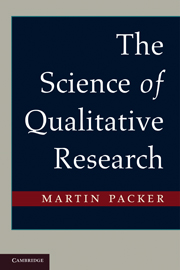Book contents
- Frontmatter
- Contents
- List of Figures and Tables
- List of Boxes
- Acknowledgments
- Introduction
- Part I The Objective Study Of Subjectivity
- Part II Ethnographic Fieldwork – The Focus On Constitution
- 6 Calls for Interpretive Social Science
- 7 Dualism and Constitution
- 8 Constitution as Ontological
- 9 The Crisis in Ethnography
- 10 Studying Ontological Work
- Part III Inquiry With An Emancipatory Interest
- References
- Name Index
- Subject Index
6 - Calls for Interpretive Social Science
- Frontmatter
- Contents
- List of Figures and Tables
- List of Boxes
- Acknowledgments
- Introduction
- Part I The Objective Study Of Subjectivity
- Part II Ethnographic Fieldwork – The Focus On Constitution
- 6 Calls for Interpretive Social Science
- 7 Dualism and Constitution
- 8 Constitution as Ontological
- 9 The Crisis in Ethnography
- 10 Studying Ontological Work
- Part III Inquiry With An Emancipatory Interest
- References
- Name Index
- Subject Index
Summary
We cannot measure such sciences against the requirements of a science ofverification: we cannot judge them by their predictive capacity. We haveto accept that they are founded on intuitions which we all do not share,and what is worse that these intuitions are closely bound up with ourfundamental options. These sciences cannot be wertfrei[value-free]; they are moral sciences in a more radical sense that theeighteenth century understood. Finally, their successful prosecutionrequires a high degree of self-knowledge, a freedom from illusion, inthe sense of error which is rooted and expressed in one’s way oflife; for our incapacity to understand is rooted in our ownself-definitions, hence in what we are.
Taylor, 1971, p. 57In the 1970s, a number of calls were made for a new kind ofinterpretive social science that would have ethnographyat its center (e.g., Bernstein, 1976; Dallmayr & McCarthy, 1977;Rabinow & Sullivan, 1979). In this chapter I will examine three ofthese calls: Charles Taylor’s proposal for an interpretive approachto political science, Anthony Giddens’s hermeneutically informedsociology, and Clifford Geertz’s interpretive anthropology. In eachcase, interpretation – hermeneutics – was regarded as animportant, even central, element. In each case, immersion in the socialpractices of a community – that is to say, ethnographic fieldwork– was considered crucial (though at the same time, as we shall seelater, ethnography itself was in crisis). In each case – insociology, political science, and anthropology – it was claimed thatthe new approach would resolve core dualisms that had plagued thediscipline. And, in each case, it was said that this would be because wewould study the key relationship of constitution betweenhumans and the world. This chapter begins our exploration of this notion ofconstitution, a notion that will lead us to a new way of practicingfieldwork. Once again, it will turn out to be important to get the ontologyright.
Information
- Type
- Chapter
- Information
- The Science of Qualitative Research , pp. 123 - 139Publisher: Cambridge University PressPrint publication year: 2010
